BMW i8 Review: What It's Like To Drive BMW's Hybrid Supercar At The Limits
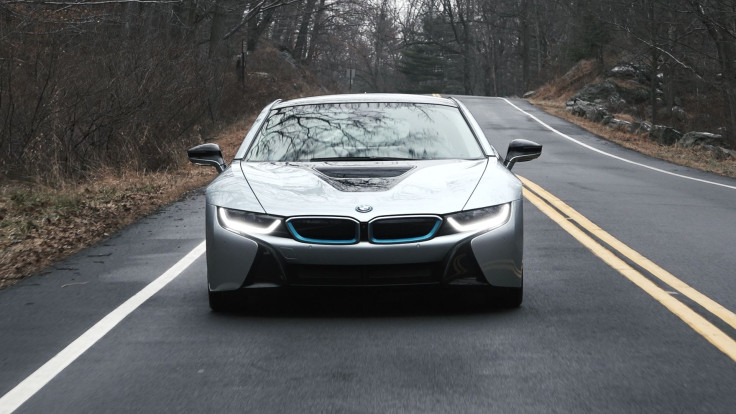
The BMW i8 isn’t a car you lust after like a Ferrari F40. It doesn’t have the same menacing presence as a Lamborghini Diablo. And it’s not a herald of luxury like a Rolls-Royce Phantom.
But in a way, it’s more important than any of those. It offers a real look into the future of sports transport for the common man.
Right, let’s clear this up now: The BMW i8 starts at $135,000. Fewer than 500 will be made every year, and it’s unlikely that any of them will actually sell for that price. BMW says that all of the 2015 U.S. models are already spoken for. But the i8 doesn’t need to be the savior of the easily available, affordable sports car, because it’s already won the battle -- it’s proof that someone can make a carbon fiber-based sports car that will hang with the best traditional sports cars, using concepts similar to the ones that companies such as Ferrari and McLaren are using for their newest batch of ultra-unobtainable hypercars.
To put this into perspective: The hybrid McLaren P1 costs $1.15 million, and if you had to ask, you wouldn’t be able to afford it. Consider that the i8 is the same basic idea (using a hybrid petrol/electric system to increase performance and efficiency), can still run 12-second passes at the drag strip, uses recycled materials, and has show-stopping butterfly doors for a tenth of the price.
If BMW can accomplish this in its first attempt on a six-figure hybrid supercar, what could cheap and midrange sports cars be in five years? Or even economy cars? Imagine a world where a Prius is actually enjoyable, and you start to see the impact the i8 could have.
It would be all for naught if the experience sucked. But it’s really difficult to dislike the i8.
Exterior

If this car is in your life, you had better be prepared for attention. Constantly. No, seriously -- traffic will stop. People will take lots of photos. But it’s not the same as driving something exotic, like one of the Italian brands. There’s just something about the way the i8 looks -- maybe it’s the common BMW badges? -- that inspires friendliness in those who approach it. I didn’t get any dirty looks or questions about how many orphans I must have sacrificed to afford the car. If a LaFerrari is a blonde Italian model with an omnipresent tinge of disgust on his face, then the i8 would be a well-built, bespectacled professor who’s loved by the neighborhood children.
The i8 gives off a friendly vibe -- just ask the plumber who shouted at us on the West Side Highway. He was so genuinely happy to see the car that he started taking pictures with his phone while he was driving alongside us at 30 mph.
When we pulled onto one of the cobblestone streets in the West Village, a photography crew halted production to talk to us and admire the car. Kids hollered and their faces lit up when their parents drove by. Cops wanted to sit in it.
It’s a fantastic piece of design, and it's so much better explained in photos than words. But those thick pillars make rear visibility pretty much nonexistent.
Interior
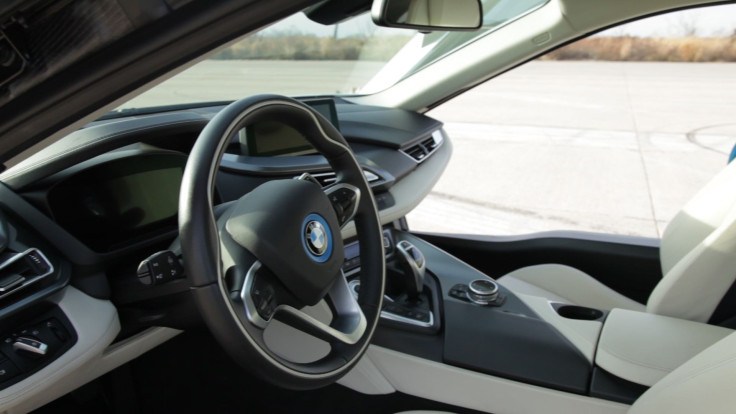
Despite the futuristic aesthetic on the outside of the i8, the interior is surprisingly simple. It’s reminiscent of older BMWs -- the cabin is incredibly driver-centric, with only a few major controls. This is a good thing.
There’s almost no learning curve to operating the i8, especially if you’ve been in recent BMWs. All of the major functions are lifted from other models, though the i8 does get its own funky steering wheel (which for some reason has manual adjustments instead of electrical). It’s about as perfect as I’ve ever used: Although it’s not a large wheel, it’s very well-padded (colloquially: nice and meaty) so that you can really latch onto it when taking corners. The three-spoke design is perfect, with divots at the nine o'clock and three o’clock spots.
The seats are equally fantastic, even if cream-colored leather isn’t a choice I’d ever make. They’re soft enough to mitigate some of the inherent stiffness in a sports car but very supportive when you’re tearing through mountain roads.
Beyond these excellent traits (and some typically spectacular BMW fit and finish), the rest of the i8 interior is a bit odd. The minimalist center console (which hides some of the car’s batteries) is elegant and comfortable, but it has only one cupholder. There are two more but not where you’d expect them -- they’re at the back, behind the driver’s elbow. Maybe this is purely an American fixation -- I’ve heard from European friends that only an American would find this odd -- but it’s quite an inconvenience if you have a passenger, and you’d both like to enjoy some drinks on your journey.
Those rear cupholders could be better used by back-seat passengers, provided you know anyone small enough to actually fit back there. Like most 2+2 coupes, the BMW i8’s rear bench is good as shelf storage and pretty much nothing else.
Toys/Electronics
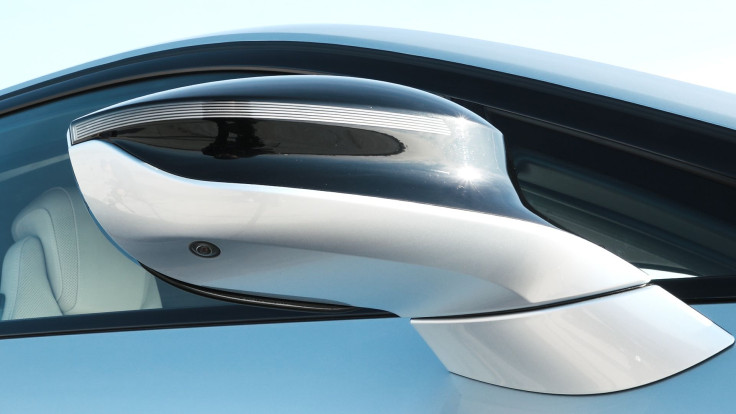
Unfortunately, because the i8 is a BMW product, it’s saddled with the iDrive infotainment system. Those who’ve used it before know where I’m going with this, but for the uninitiated I have one word to describe iDrive: horrendous.
Has it improved since its inception? Yes. But it’s still frustrating, convoluted and illogical. The control wheel on the center console is used for all of the inputs from map navigation to music selection. A wheel is an imprecise, clumsy apparatus to use with a menu interface, but it wouldn’t be so bad if the iDrive user interface were simple.
Yet iDrive has submenu after submenu to adjust some of the most essential settings (e.g., two submenus to alter treble/mids). Browsing the map would be much more intuitive with a touch screen, but iDrive uses the wheel to expand and browse the map. It takes so long to figure out what area you might be looking for that it’s just more efficient to recruit a smartphone.
If nothing else, iDrive at least responds quickly to more frequent functions such as Bluetooth commands and media playback.
One last thing you’ll notice inside the i8: It's quiet. In “eDrive” or “Comfort” modes, there’s almost nothing to be heard -- not even the racket made by the set of snow tires BMW mounted for us.
But if you pull the gear lever to the left and activate the “Sport” mode, the cabin fills with the burbling, fabricated sound of the i8’s 1.5-liter, three-cylinder engine. Is this a bad thing? I tend to lean toward yes with other cars that do this, but some systems are better/more natural than others. BMW’s system uses the stereo to replicate induction noise, so it’s entirely fake -- and as much as I dislike the system, the sound it makes is quite good.
Powertrain
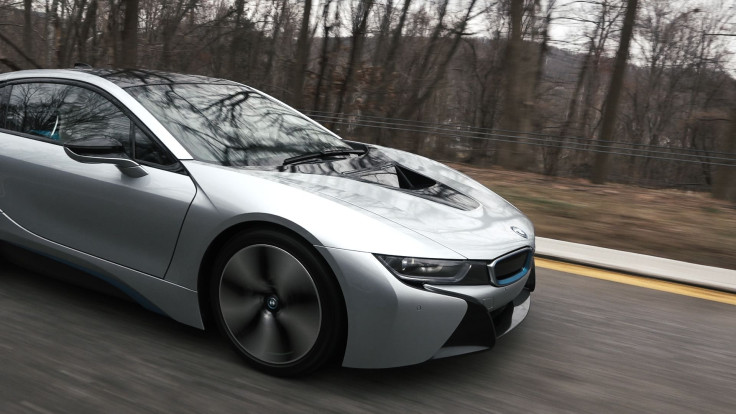
The i8 is a hybrid, in the same (very) general way that a Toyota Prius is a hybrid: there’s a traditional petroleum engine paired with a set of electric motors (one large, one small) and a set of batteries, all working together to provide propulsion.
When’s all is said and done, the i8 has 357 horsepower and 420 foot-pounds of torque that can move the nearly 3,300-pound BMW to 60 mph in under four seconds during ideal conditions -- that’s about as quick as a C7 Corvette Stingray. Our tests (performed in mid-December with snow tires) averaged 4.4 seconds.
A 129-horsepower/184-torque electric motor drives the front wheels. That’s not a large amount of power, but it’s more than enough to get the i8 moving through towns and keeps things quiet on the highway.
Behind the passenger compartment lives a 1.5-liter petroleum engine that shares roots with the Mini Cooper. In the Mini, it makes around 130 horsepower and 160 torque; in the BMW, it makes 228 horsepower and 236 torque. To make that much power from an engine that small with only a single turbocharger is a feat in and of itself, but even more impressive is the harmonious line the two walk.
When you start the i8, you can just putt around in all-electric (eDrive) mode, or quietly in hybrid (Comfort) mode, barely making a sound or using fuel. But the second you decide you need a little more power than the electric motor is able to grant, the combustion engine awakens, gives you the boost you need (plus a little extra for good measure), then goes right back to sleep. This all happens with such precision and swiftness that, were it not for the faked engine noise, most people wouldn’t know anything special had happened.
Of course, if you switch to Sport mode, the engine is always on -- and the rear axle stays active to keep the i8 in all-wheel drive. But even at full throttle and with the windows down, the i8 isn’t deafening. I’m not entirely sure I love the exhaust note; Chris Harris described it as “like half a [Porsche] 911,” and I’m inclined to agree. But I’m not a fan of the 911, so there’s that.
Handling
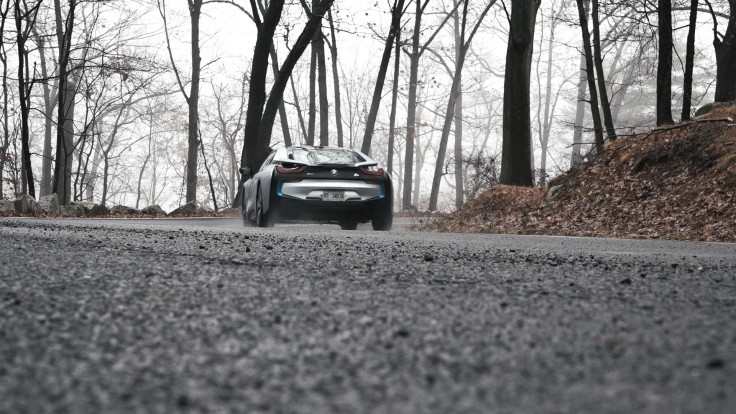
Driving the i8 hard is so ridiculously easy that it makes one wonder why this is the first midengine production car BMW has built in 35 years? While I wouldn’t call the i8 the most deft thing out there -- it has a long wheelbase, after all -- it's swfit for its size and bites hard on initial turning, though the car will always understeer when you get too aggressive.
It made easy work of our mountain course (Bear Mountain), diving into low- to midspeed corners and rocketing out of sweeping corners. The roads are tight, so the i8’s cautious setup fit in very well. But on more open roads, the i8’s recalcitrance was a bit odd. Sure, when the going gets tough, the car is all-wheel drive, but it’s really unwilling to break the rear end loose. For the record, the i8 let me hold a four-wheel drift at an absurd speed very briefly -- maybe for one second -- then the computers checked both the steering angle and my ego. So, it’ll allow a little bit of tomfoolery, but it’s quick to smack you back in line.
Despite this bit of nanny-like quality in its personality, the i8 is a total joy to push. The steering, though a bit light -- alas, electronic steering tends to be that way -- is otherwise spot-on. There’s plenty of digital feedback midcorner, and the system makes the i8 incredibly easy to place and predict.
You have to teach yourself to be one gear up in corners, though, especially if you’re used to small combustion engines. Typically, you’ll downshift once or twice before slower corners, so the engine will be higher in the rev range, since that’s where the bulk of power usually exists in those engines. But the i8’s electrical motor provides near-instant torque assist when you’re powering out of a corner, so if you treat the car the same way you’d treat a normal one, you’ll hit the redline right away. If you think you need to be in second gear for that corner, stay in third. You’ll exit quicker that way in the i8.
Perhaps part of the fun is knowing you’re doing the same kind of back-road hooliganism normally associated with traditional sports cars in a hybrid -- especially if your first association with that word is the same as mine: Toyota Prius. There’s just something so wrong about it, coming from decades of traditional cars. It defies what you think a sports car should be.
Experience
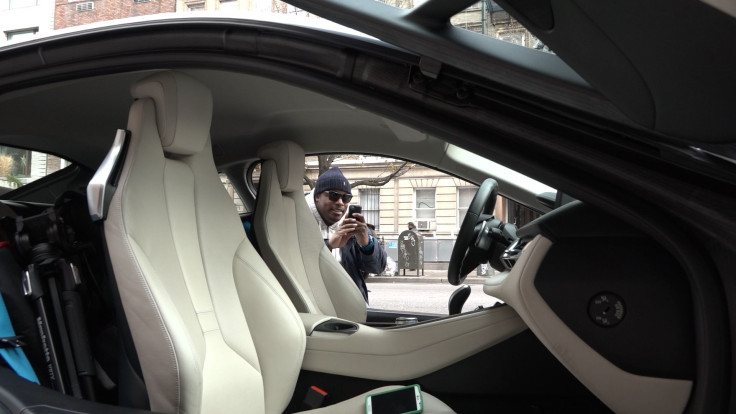
It’s difficult to put into words just how special driving the i8 makes you feel, but then, that’s sort of my job, so I should get on with it.
Nothing I’ve ever driven has given me the same feeling that the i8 did. I was an idol, and those around me, even most strangers, celebrated my arrival and mourned my departure every time. They wanted to know more, they wanted photos, they wanted to talk forever. They couldn’t get enough.
This, I thought, is probably a taste of celebrity. It was one of the reasons I came to love the i8. It was an invigorating feeling --at first.
You can only shake so many hands, stop for so many pictures, talk to so many people in a day before your supply of goodwill is depleted. The i8 is a car and functions in much the same way as any other, but you can’t use it to just go somewhere. Every drive is an event -- not so much for you as for those around you. And sometimes, you just want to get a damn cup of coffee without being bothered.
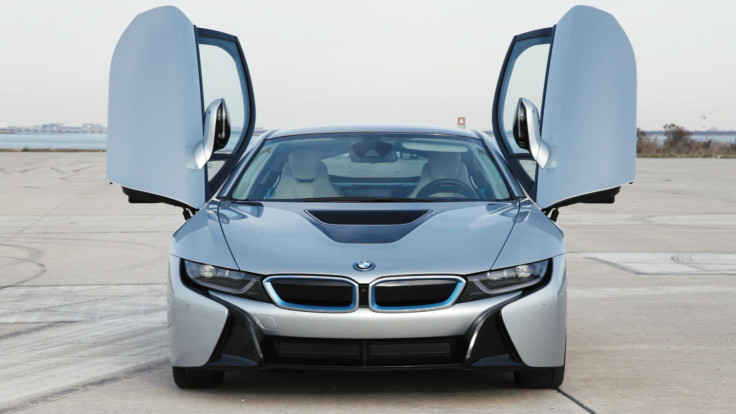
This, I thought, is probably a taste of celebrity. It was why part of me came to loathe the i8. The attention quickly became overwhelming. I began to understand why so many supercar owners keep their special possessions hidden away most times, electing to drive something a bit more mundane to go about their daily business.
Away from large congregations of onlookers, the i8 is a magnificent, surreal machine, and no amount of Brooklyn photo requests can take that away from the car’s overall appeal. In my life, I’ve fallen for very few cars, but the i8 has quickly made its way on my list.
If this is the future of motoring, I think we’ll all be OK.
© Copyright IBTimes 2024. All rights reserved.






















